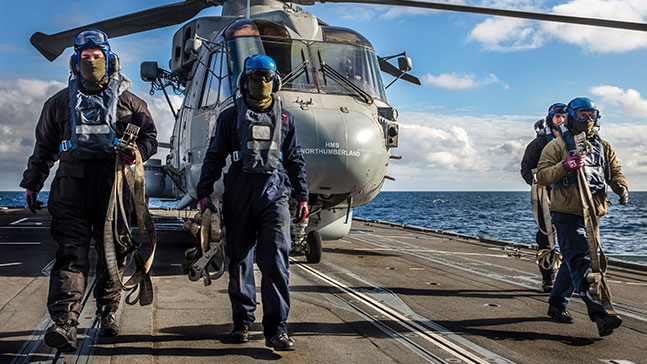Air Engineer Officer
Lead the specialist team who makes sure our cutting-edge aircraft are ready for action, in challenging situations, all over the world.
High interest role
This is a highly competitive role with potential long lead time to join.
You may wish to consider joining the Royal Navy in one of these similar roles:
- £31,000 - £110,500
- Undergraduate Degree
- Fleet Air Arm
- Engineering
- Officer level
£27,000
£31,000
£38,000
Extra pay
6 weeks
Travel

It’s a challenging role and full of high pressure situations, but I know I help to keep the Royal Navy – and my team – flying, which is incredibly rewarding.
Role details
What you’ll do
When you join the Royal Navy as an Air Engineer Officer, you’ll lead the people who ensure our aircraft are ready to take off at a moment’s notice. A team of highly-trained aviation engineers will look to you for advice, guidance and support on a daily basis as they tackle a range of complex problems, in challenging environments, all over the world.
You’ll use your knowledge and expertise to guarantee the safety of our pilots and the reliability of our aircraft. Without you, our planes and helicopters stay grounded, and our reach is reduced.
Your role
- Lead a team of specialist Air Engineering Technicians. They’ll rely on you to mentor them, and in return, you’ll get to see them develop into the engineers of the future.
- Collaborate with fellow industry specialists to develop new aviation solutions, from concept, to testing, manufacture and application.
- Take overall responsibility for maintaining, updating, fitting and testing our planes and helicopters, at Royal Naval Air Stations (RNAS), and on board ships all over the world.
- Work with some of the most advanced propulsion, weapons, navigation and control systems in existence, using your in-depth knowledge to find innovative solutions, often under extreme pressure.
Pay & benefits
- A starting salary of at least £31,000, rising to around £38,000 after just two years.
- An excellent non-contributory pension scheme – we pay into it for you, so you don’t have to sacrifice any salary.
- A £27,000 joining bonus.
- Six weeks of paid holiday every year
- Amazing opportunities, including world travel and adventurous training for two weeks every year.
- Free gym and sports, from football to kayaking to kite-surfing.
- Forces Help to Buy scheme – a 0% loan to get you on, or further up, the housing ladder.
- Subsidised travel, accommodation and food.
- Handy discounts with lots of top brands, from Marriott hotels to Audi cars and high street stores.
Skills for life
Qualifications you'll gain
- Become an internationally recognised Chartered Engineer – we’ll support your professional registration.
Opportunities open to you
- There are also many opportunities to get involved in post graduate study, for example, you might work towards an MSc in Military Aerospace, Airworthiness and Cyberspace operations.
Skills you'll develop
- Learn how to lead people in a highly pressurised environment.
- Build your team-working skills, working as a valued member of our management team.
- Gain an in-depth understanding of avionics and mechanical engineering – from the rotor system of a helicopter, to the weapons of a fighter jet.
Eligibility
- You’ll need to be aged between 18 and 39
- All Science, Technology, Engineering and Mathematics (STEM) degrees will be considered
- You’ll need a minimum of 96 UCAS points or Scottish equivalent). At least 64 points should be in maths and an engineering-based science. These can be accrued from either GCE A/AS Levels (or equivalent) or National Diplomas (e.g., BTEC).
- You’ll need at least 5 GCSEs at grades A*-C (9-4) (or Scottish equivalent), which must include English language and Mathematics
- You must be a United Kingdom citizen or British Dual National. Dual Nationality restrictions do apply
- You must have lived in the UK for 5 years continuously prior to application
- Minimum height of 145cm
- A Body Mass Index (BMI) between 18 and 28 (between 17 and 27 if under 18)
Skills & interests
- An ability to thrive on responsibility and lead from the front
- Confidence making key decisions in high-pressure situations
- A passion for cutting-edge engineering
- An aptitude for solving problems
Joining process
From picking your role to the first day of training; everything you need to know as an officer
Submit an application
Defence Aptitude Assessment (DAA)
You’ll be tested on: Verbal Reasoning, Numerical Reasoning, Work Rate, Spatial Reasoning, Electrical Comprehension and Mechanical Comprehension.
To prepare, you can practise the DAA
Interview
Medical and eye tests
Pre-Joining Fitness Test (PJFT)
Interview
Admiralty Interview Board (AIB)
This stage is unique to officers and takes place in two parts. A Pre Recorded Interview (PRI) is an online assessment which assesses your motivation to join the Royal Navy as an officer and your awareness of the Royal Navy. The Group Planning Exercise (GPE) is the second stage of the AIB and is an online competency based assessment which will take place on a separate day to the PRI. It will be conducted in a virtual group environment and you will be assessed on your contribution to the team based on your individual performance
Career progression
Got a question?
Our virtual recruiter is available to answer your questions 24 hours a day
